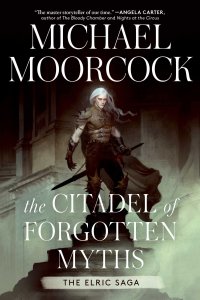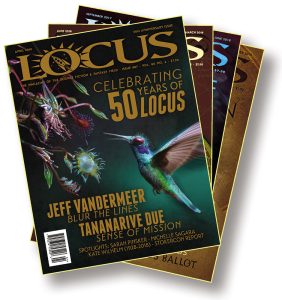Paul Di Filippo Reviews The Citadel of Forgotten Myths by Michael Moorcock
 The Citadel of Forgotten Myths, Michael Moorcock (Saga 978-1982199807, hardcover, 336pp, $28.99) December 2022.
The Citadel of Forgotten Myths, Michael Moorcock (Saga 978-1982199807, hardcover, 336pp, $28.99) December 2022.
The legendary quip asserting that “The Golden Age of science fiction is thirteen” needs to be modified in my case, and, I suspect, in the case of many other readers. My personal Golden Age of SF lasted a decade: from the moment in 1965 (I was ten) when I discovered Raymond F. Jones’s The Year When Stardust Fell, to the moment in 1975 when a college professor told me I could read Gravity’s Rainbow for extra credit. In that interval I read hundreds of hardcore, genre-centric SF and fantasy novels and collections, sometimes two a day (books were smaller then), imprinting on modern SF/F/H and building my understanding of it. To be sure, I had encountered some types of SF prior to 1965 (Tom Swift, for instance), and, likewise, I continued to read heavily in the field after my college awakening to the charms of mainstream and slipstream classics. But that period from 1965 to 1975 was unique in my private biblio-history. Jo Walton captures some of the same sensations in Among Others.
If you had catalogued the authors I loved best during this time, you would have seen many familiar names: Norton, Heinlein, Dick, Ballard, Delany, Zelazny, Aldiss, Simak, Asimov, Sturgeon—and Michael Moorcock. My love for and fascination with his work continued right down to the present, and so I am thrilled to report that his newest installment in the Elric saga finds the Grand Master at the top of his game. It’s a book that manages to impart to me the same thrills that Stormbringer did when I first read it.
Of course, as we all know, Elric’s long biography is incredibly dense and complicated with names and places, incidents and myths, and his actual mortal life has already reached its literary end in Stormbringer, rendering the current title an interstitial, backfilling one. I myself have become slightly untethered from all the lore over the years, but found that my enjoyment of the newest did not suffer at all, since Moorcock elegantly conveys everything we need to know. And since there are many new characters, all readers are on an equal footing in that regard.
By the way: the savants at Wikipedia have already slotted this newest into place in Elric’s internal chronology, putting it way back in second-earliest position, after only Elric of Melniboné.
Moorcock makes a brilliant maneuver at the start by delivering Elric and his constant companion Moonglum into an entirely new world, far from the fields they know. With the pair being as ignorant as we are of the new local layout and forces, explanations and discoveries can proceed with an easy naturalness.
Our pair of adventurers, with some chance-met female companions, have left the remnants of Melniboné to go questing. They are on a ship which is voyaging to the World Above, a kind of mirror dimension to the familiar one. The transition is abrupt. “And then suddenly there was the sensation of falling, falling as the ship plunged over the edge, falling forever, it seemed…” Then they are in the new realm.
Part One of the tale finds the pair in a Dunsaynian landscape of cities and country estates. They meet up with one Lady Forentach, who happens to have a certain connection with the Phoorn, the dragon ancestors of Elric’s race. Soon Elric and Moonglum are enlisted to serve in her campaign of vengeance and justice. This relatively short and self-contained adventure is thrilling, but has less bearing on the future than what comes next.
Part Two finds the pair leaving behind their port of entry for the land of Soom, there to seek the Black Anemone, a unique plant that might help Elric’s condition of eternal weakness that only the deadly use of his Black Blade can intermittently repair. Elric meets a cousin of sorts, one Dyvim Marluc, who will figure significantly later on.
The quest for the Black Anemone is a Pyrrhic victory, forcing the companions back on the road and into Part Three, the longest and most impactful of the adventures. Elric rescues a queen, Melaré, from captivity, accompanies her to her lovely city of Kirinmoir (suspiciously populated mainly by women and their tame bees that make a strange blue honey), and ultimately finds himself a pawn in the war between the Chaos gods Arioch and Xiombarg. The scope of action becomes monumental, before a fateful epilogue.
As I recall my youthful reading of the Elric books, they reveled in a kind of black-humor-relieved grimness that embodied a stylish Nihilism Lite. A very cool and slightly campy Sixties aura pervaded the series, not without emotional power, but still more ludic than earnest. This volume, however, shows more gravitas. Elric’s condition and fate assume truly Wagnerian proportions which are simultaneously more heartfelt and intimate.
By the point towards the end of the tale, when one of his dragon ancestors speaks to him, the reader’s sympathies are fully engaged on Elric’s behalf.
“I respect you for the destiny you will fulfil and for the great sacrifices you will make, for you were born, Elric of Melniboné, to suffer all the world can do to make a mortal suffer, to lose what is most painful for a mortal to lose, and your reward for that for that will be unbearable loneliness, terrible grief and hopeless death; the death of memory and friendship. You will be remembered in your histories as a pale and nameless shadow and in your myths as one of many doomed heroes.”
Also evident in this iteration is a welcome deepening of the character of Moonglum, who was always a source of comic relief, Sancho Panza to a dark Quixote, but is now somehow much more savvy and wise, as well as being a scholar and writer, a Doctor Watson in fact.
Moonglum had no title for what he was calling the Journal of the Black Blade, and as he finished a scroll or book, he would send them by a courier to his Library at Pnetochnic University in the Zcvvv, Scholar-City of Hoolin, where his papers awaited his old age…
Moorcock’s ability to convey action vividly, to envision otherworldly vistas, and to couch it all in elegant prose remains undimmed. I mentioned Lord Dunsany as a predecessor for Moorcock, but I would also have to enter Clark Ashton Smith as an inspiration and coequal. This alliance extends to Moorcock’s great ability to conjure up names, although I did object to one such: the evil Ramada Sabaru. The given name, of course, instantly evokes a hotel chain, while the surname echoes a carmaker. But aside from that, all is Vancian perfection.
This could very well be the final installment of Elric’s long exploits, and if so, Moorcock can retire proudly from the walls of Imrryr.
 While you are here, please take a moment to support Locus with a one-time or recurring donation. We rely on reader donations to keep the magazine and site going, and would like to keep the site paywall free, but WE NEED YOUR FINANCIAL SUPPORT to continue quality coverage of the science fiction and fantasy field.
While you are here, please take a moment to support Locus with a one-time or recurring donation. We rely on reader donations to keep the magazine and site going, and would like to keep the site paywall free, but WE NEED YOUR FINANCIAL SUPPORT to continue quality coverage of the science fiction and fantasy field.
©Locus Magazine. Copyrighted material may not be republished without permission of LSFF.






